Presidents: Lyndon Baines Johnson
Lyndon B. Johnson National Historical Park, Texas
Visited in 2008 and 2017.
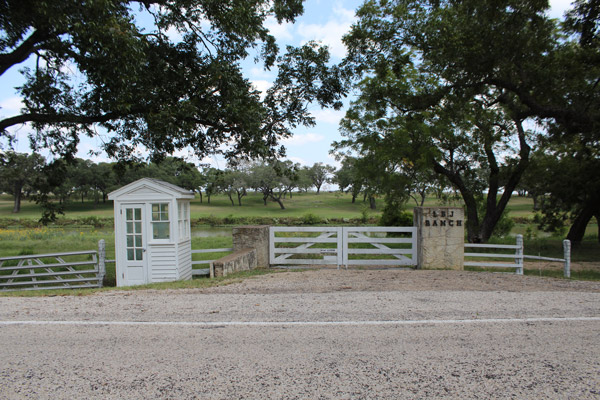
Welcome to LBJ's birthplace, home, grave and image factory.
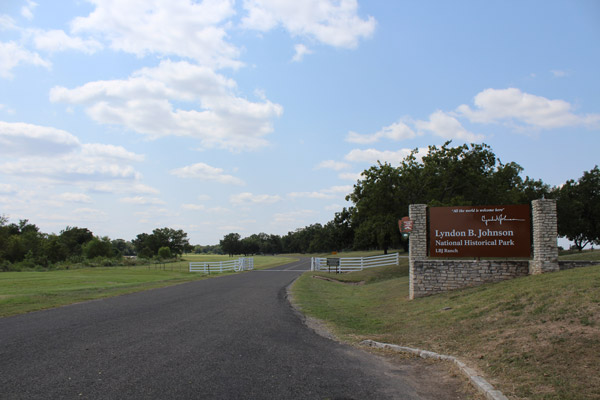
The driving entrance to the ranch, along the Pedernales.
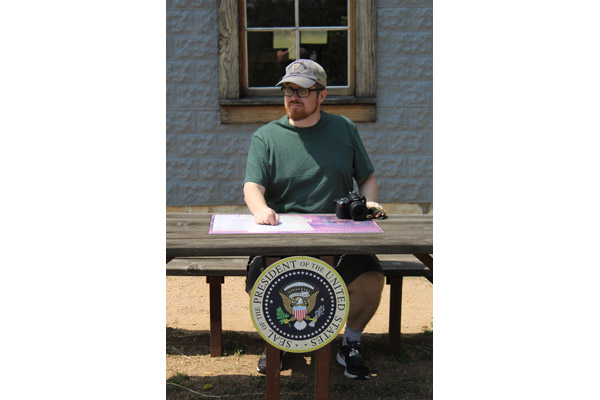
Re-creating the signing of landmark education law, in front of LBJ's old schoolhouse.
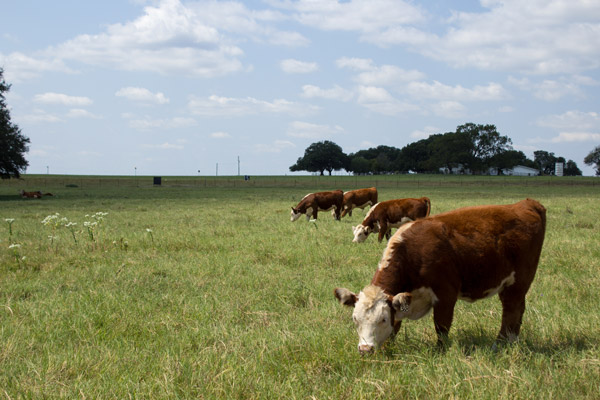
The Johnson herd does its thing, out in the fields.
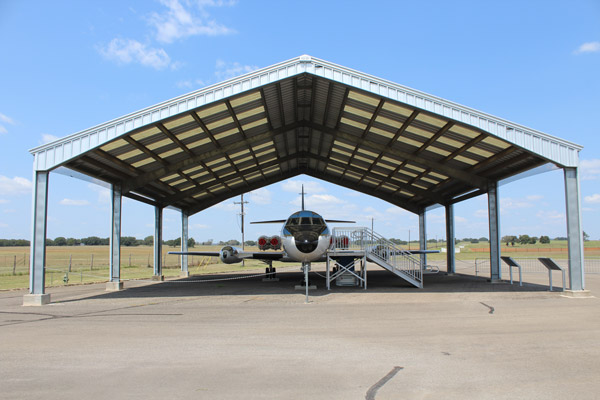
Air Force One Half, the tinier plane that could fit on the ranch's landing strip.
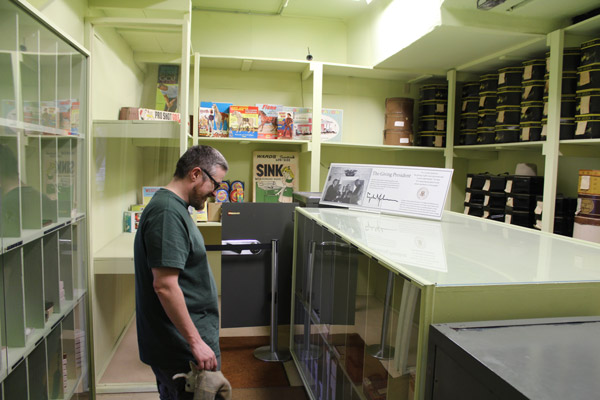
Inside LBJ's gift locker, where he kept souvenirs (hats, ashtrays, etc.) to give to visitors.
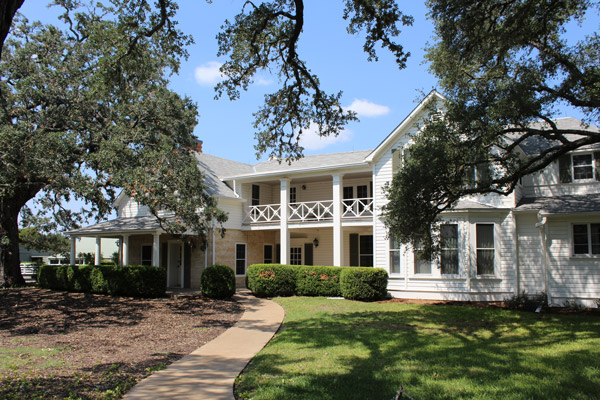
Walking up to the Texas White House.
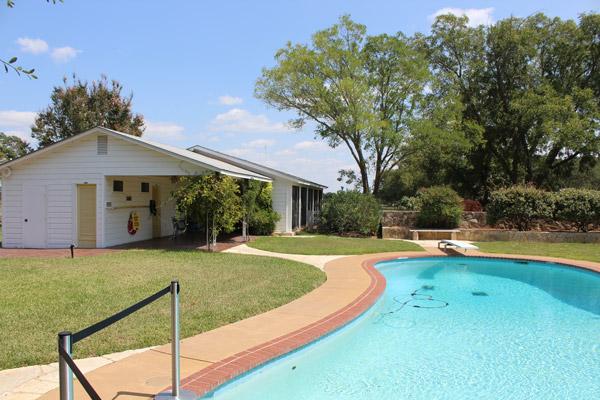
LBJ's pool and pool house. He took phone calls while swimming, when that wasn't easy to do.
There was a president from Texas once who spent a staggering amount of time on his ranch, cared deeply about education and presided over a transformative and often unpopular war. And he was a Democrat. Who says America isn't bipartisan?
A lot of president's homes are just houses with artifacts, and while it's deeply moving to see the dinner set Rutherford B. Hayes ate off of, what does it really tell you about the man, aside from his exquisite taste in flatware? The LBJ ranch, just west of Austin, is more like the LBJ Experience -- you cruise around Hill Country, soak in the atmosphere and contemplate a way of life.
In 1908, the Texas hill country was basically "No Country for Old Men," without all the annoying civilization. There was no running water, no electricity, and no Ford F150s with truck nuts. LBJ was born into that life, in a one-story house on his family's cotton farm, not far from the Pedernales River. That house is gone, but there's a re-creation there today.
From that house, young Lyndon could walk up the river to his grandfather's house and get peppermint sticks. He could walk down the river to the one-room schoolhouse where he was enrolled at a very young age. (His mom supposedly greased the skids, because as a teacher she highly valued education, and she also wanted day care so that LBJ wouldn't drown in the river. And thus the seeds of Head Start were planted.) As president, LBJ signed one of the biggest education programs in U.S. history into law, in a ceremony in front of that schoolhouse.
Unfortunately, the land was appallingly unsuited to cotton farming. This problem was compounded by the fact that Sam Johnson was an appallingly bad farmer. When LBJ was 5, the family was on the brink of ruin, and his father moved them 15 miles east to Johnson City. (Which, if you have to move, it's probably best to go to a town founded by your relatives. It makes things simpler when you're trying to move up the ranks in the PTA.) Visitors to Johnson City can visit Lyndon's boyhood home, which was on a 1.5 acre plot. LBJ's dad did odd jobs, read the law, and made the trip back to the family farm on occasion. He was also a regular in the Texas state legislature, although that was only a part time job, because Texans chose long ago to settle most legal disputes by shooting wildly into the air and punching nancies in the mouth. But it did make politics a family affair, and when rough men show up at your house to drink and curse and cut shady deals with your dad on your front porch, that's going to leave an impression.
LBJ finished high school at age 15 and was president of his graduating class -- of the six people in the class, I supposed he was the most popular. He bummed around doing odd jobs in California for a few years, then came home to Texas to get some more schooling. He ended up with a teaching certificate, just like his three sisters and his mother, who obviously did a good job hammering home the importance of edumacation. In 1931 he went to Washington to be a legislative aide to a Congressman; he gladhanded his way to a New Deal job in Texas in 1935; and at the age of 28 in 1937 he ran for Congress. He announced his campaign from the porch of his boyhood home. He ran on a platform of modernization -- bringing power and water and modern amenities to the land he had grown up in, after years of having to share a bathroom with his three sisters without those benefits. He won, and he delivered on his promises.
The ranch came back into play in the 1950s, when LBJ acquired it from a relative. As the story goes, it was a place he had to visit to "recharge his batteries" after long weeks of 20-hour days railroading people into doing his bidding. They have recordings of friends and aides describing how a drained man on Friday night would slowly fill up with piss and vinegar by Monday morning. The ranch is a functioning cattle ranch -- there was no attempt to revisit the nightmare of cotton -- and LBJ raised Herefords. The park service keeps it running today, per the terms of LBJ's will. So people driving through the fields might have to patiently wait for a giant beast to waddle out of the road.
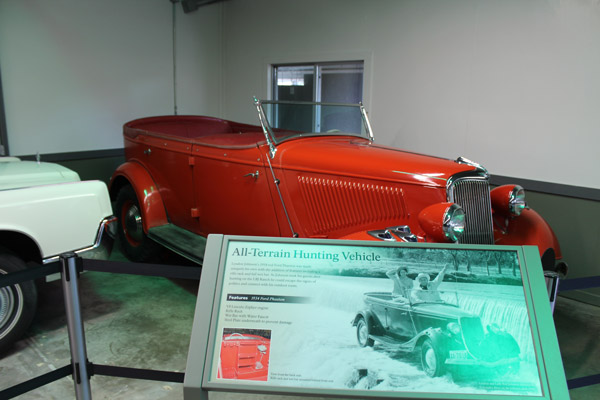
Inside the car barn, looking at Johnson's ATV.
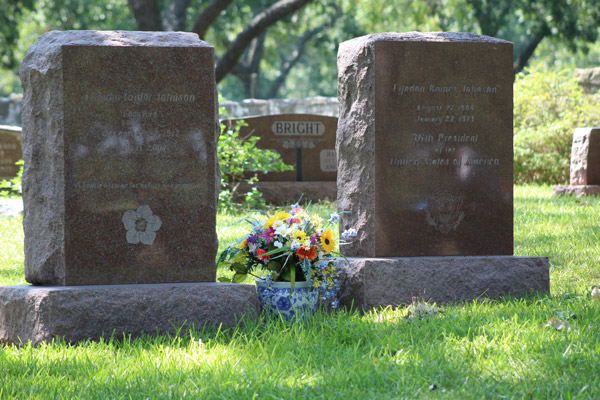
That's Lady Bird on the left and LBJ on the right.
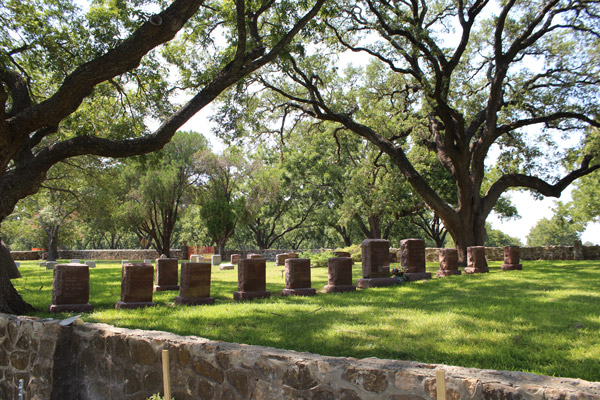
A wider shot of the Johnson family cemetery and its giant oaks.
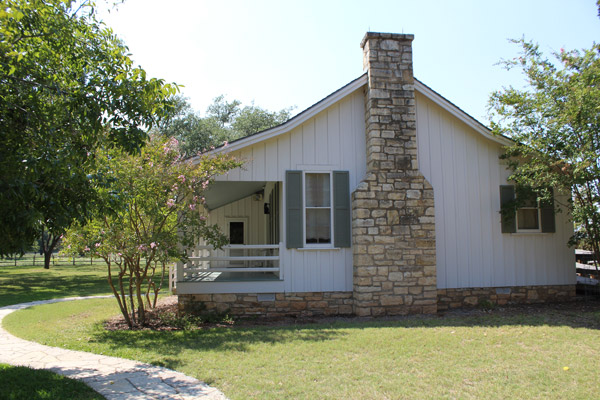
If memory serves this is the replica of LBJ's birthplace.
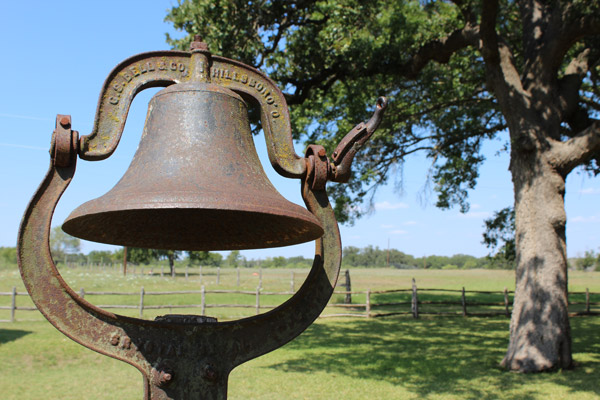
Ranching rings my bell.
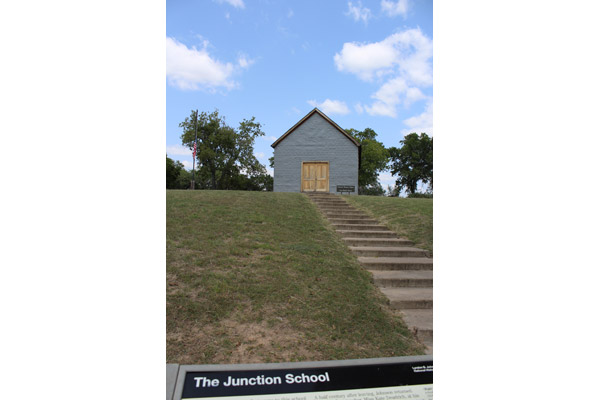
The approach to the old one-room schoolhouse.
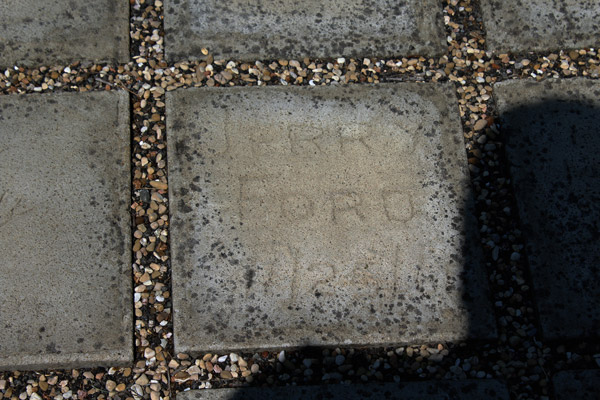
On the grounds of LBJ's house is a patio of squares with the signatures of famous visitors.
You drive around the back of the house, past the "show barns" and the tiny air strip where LBJ's plane landed. (They called it Air Force One-Half because the regular presidential plane was too big for the runway.) If you want you can stop in the "car barn" too, where some of LBJ's favorite vehicles are parked. That includes an all-terrain hunting vehicle, and LBJ's aqua car -- he would take people for rides, not tell them it was an aqua car, drive toward a lake and pretend the brakes weren't working.
The house was off-limits when Lady Bird Johnson was living there. But she died in 2007, and once the prep work was done, visitors were welcome. (No pictures allowed inside.) They walk you through LBJ's office, wired with an absurd number of phone lines. You can see the surprisingly modest kitchen, where Lone Star beer was on tap for guests. LBJ's bedroom is a decent size, but not huge. The living room is fairly modest as well. It's a cozy residence, considering that huge entourages would be staying there whenever LBJ was home. Guests were packed in.
The big challenge to every visitor is figuring out what to believe. Johnson was by any standard a world-changing president, through his efforts on Vietnam, civil rights and the Great Society programs. He had powers of persuasion that were legendary and an unwavering faith in the ability of government to improve people's lives. When you see traces of the Hill Country's past, you can understand why.
But Johnson was also acutely aware of his image. The first time I visited, in 2007, you accessed the ranch via a small bus. Before you boarded the bus, they had you watch a 1966 NBC News special in which Johnson -- whose popularity was beginning to tank -- takes a reporter on basically the tour you are about to experience. It's filled with beautiful shots of the countryside, and stories about humble beginnings, and LBJ talking about the clarity and serenity he drew from being home. The message on the tour today is basically the same as in 1966.
Johnson wasn't a badass cattleman -- most of his money came from shady business deals involving TV and radio stations. He didn't relish physical labor But he wanted to look like a rancher. Taking over for the uber-sophisticated John Kennedy, LBJ wanted to establish a brand of his own; as a rancher, he could leave press conferences on horseback, brag to visitors about the size of a bull's testicles, and do generic cowboy things. The replica of his birthplace was built on his orders, because he knew he was building a set for the LBJ Experience. He kept some of his relatives nearby, in case he needed to trot them out to reporters. They would tell carefully crafted (and sometimes demonstrably false) stories of Johnson's youth, all meant to reinforce the narrative LBJ was building.
That narrative stands in contrast with so many things we also know about Johnson. (If you can, read Robert Caro's multi-volume biography, which might be the best presidential biography to date.) Johnson was manipulative and brutish, often terrorizing colleagues and employees with withering emotional abuse. He was a known liar, he was willing to condone unethical or illegal activities to win elections, and he was also a womanizer. People cringed at the way he treated Lady Bird, as he would berate or humiliate her in front of large groups. His negative qualities were put in service of arguably good causes, but he had a LOT of negative qualities.
You wouldn't expect any presidential site to wallow in moral ambiguity, though. There is also value in seeing the manufactured image, which has absolute historical importance.
And if you need something that's clearly authentic, there's nothing more honest than a graveyard! The Johnsons are buried in a simple enclosure dominated by two beautiful oak trees. For a man who was larger than life, LBJ has an understated marker. And Lady Bird is right beside him.
LBJ Presidential Library, Austin, Texas
Visited in 2017.
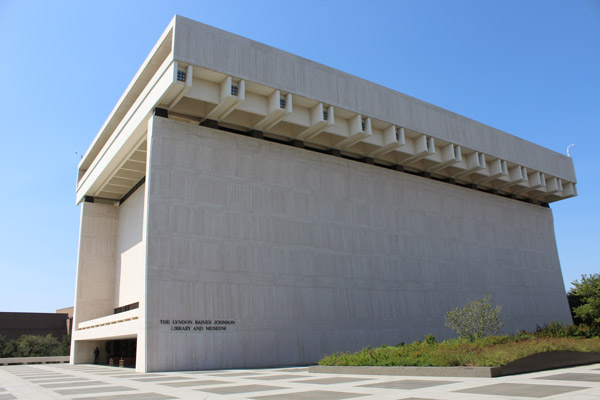
The exterior of the library, on the University of Texas campus.
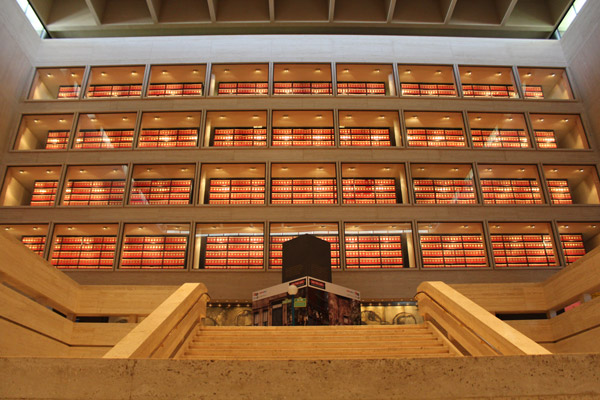
The stacks! Each of those red boxes contains documents from the LBJ administration.
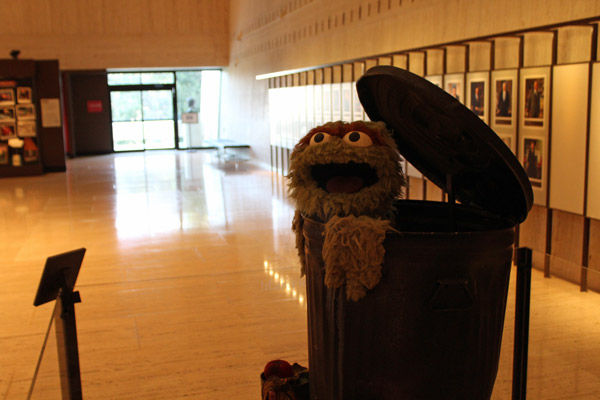
LBJ helped pave the way for public broadcasting, so Oscar gets a spot in his museum.
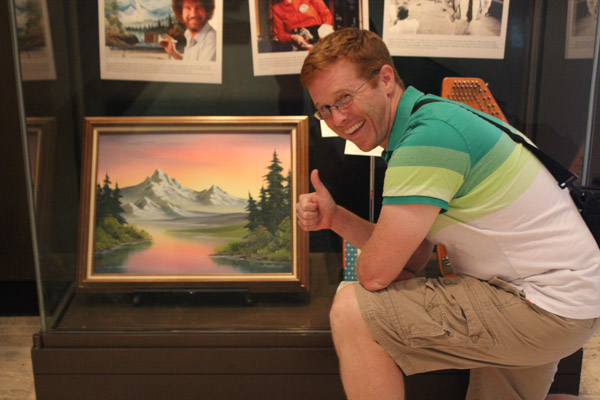
Yes, I'm a happy little presidential history freak.
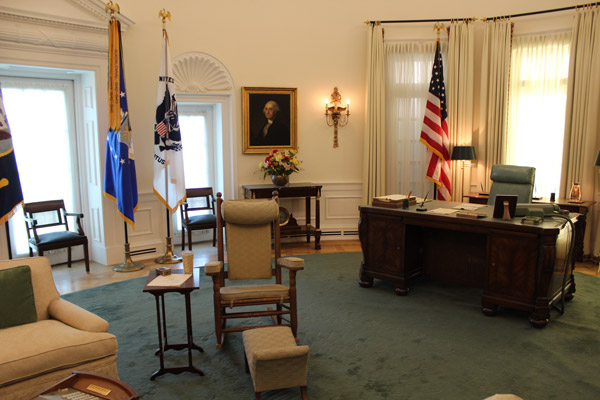
The replica of LBJ's Oval Office, to 7/8 scale.
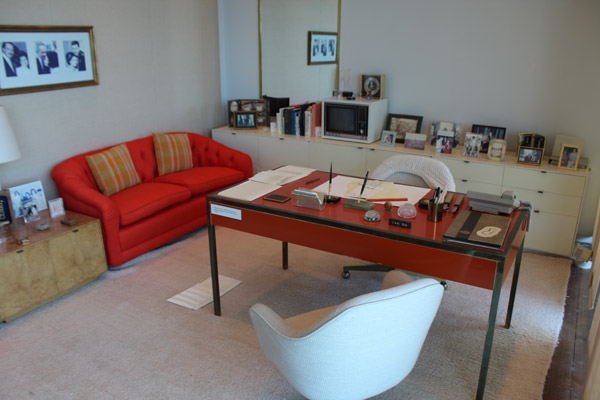
Lady Bird's office in the library -- which she used for decades after her husband's death.
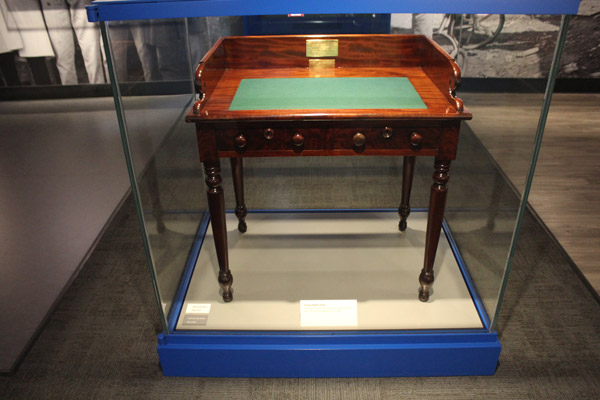
I think this was the desk where the Voting Rights Act was signed.
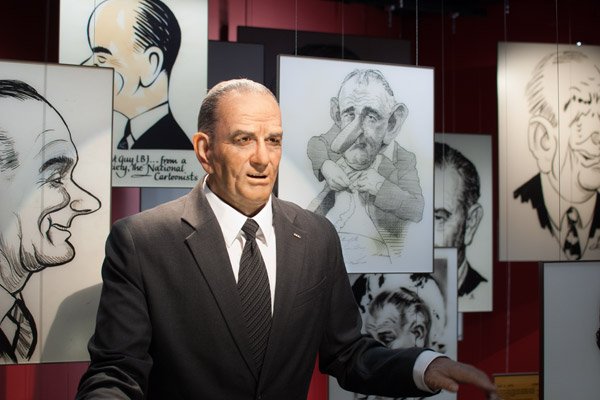
Do they have a creepy animatronic joke-telling Johnson? You know they do!
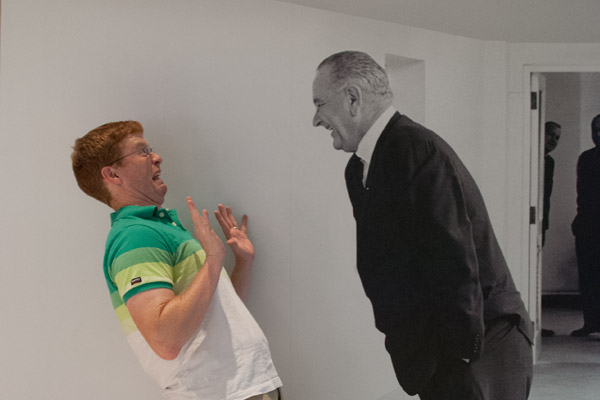
Nice photo op where they let you experience "the Johnson treatment."
The men in Lyndon Johnson's family died young, usually from heart trouble. Some people (such as biographer Robert Caro) believe that LBJ's faith in his early demise is what drove him to work so hard. When he reached middle age, he no longer had patience for the long game; political opportunities had to be seized as soon as possible, because there was no guarantee of future opportunities.
Whether it was fate or a self-fulfilling prophecy -- where fear of dying drove him to work so hard that the stress killed him -- history proved him right. His heart was weakened by a massive cardiac event in his mid-40s. The strain of the presidency led to more incidents. A final heart attack felled LBJ in early 1973, just a few days after Richard Nixon started his second term. Johnson was alive for the dedication of his presidential library and museum in 1971, but he didn't get to stage-manage his legacy for very long.
His wife picked up some of the slack. Lady Bird kept an office in the library for decades, managing her personal affairs and sharing her insights into LBJ's career. (Shocker, she was kind to her husband and didn't dote on the many ways he treated her like garbage.) Beyond that, LBJ definitely left behind plenty of positive stuff to dwell on, particularly in the field of civil rights. There are enough feel-good stories to populate some first-rate exhibits.
But to my mind, the greatest monument to LBJ is the sheer volume of information left behind. Most NARA facilities focus on the museum experience, because most visitors aren't academics. Usually you're herded into carefully curated displays, and the library facilities are discreetly out of sight. The LBJ library has its museum, with all the usual timelines and artifacts and Oval Office replicas. I particularly enjoyed the Sesame Street tribute, as LBJ helped usher in public broadcasting; a very helpful sign by the Count Von Count puppet assured me that he was not a vampire, but merely a thickly accented eccentric who loves math. Whew.
However, my lasting memory is of the stacks. The building itself is a stone monolith, which actually looks like a giant filing box (with the lid on) rising out of a concrete plaza. Once you're inside, you see the boxes within. The building's atrium has a four-floor interior window, revealing hundreds of neatly ordered rows of bright red boxes. These are the Johnson papers, or at least a small visible sliver of that collection. It's one of the most stunning views you can find at any presidential library, as it drives home in seconds the obscene complexity of understanding any modern presidency. You could spend a lifetime sifting through those boxes, uncovering a thousand versions of the truth.
The museum also creates other points of contact where a casual visitor can appreciate the power of the archives. While president, LBJ recorded hundreds of hours of phone conversations. There are a few stations where you can pick up a receiver, hit a button and hear icons of the 20th century chatting with each other. (To name a few, Eisenhower and MLK Jr. were recorded.)
Johnson was a master manipulator and an aggressive salesman. If he had decades to shape his library, it might have ended up a meaningless facade -- not unlike the JFK library, which thanks to the heavy-handed hagiography of the Kennedy family is a hollow experience. The way it is, I enjoyed the weight of the information around me. It seemed like a testament to all that Johnson accomplished in a short life, and also a reminder that hey, it's complicated.
